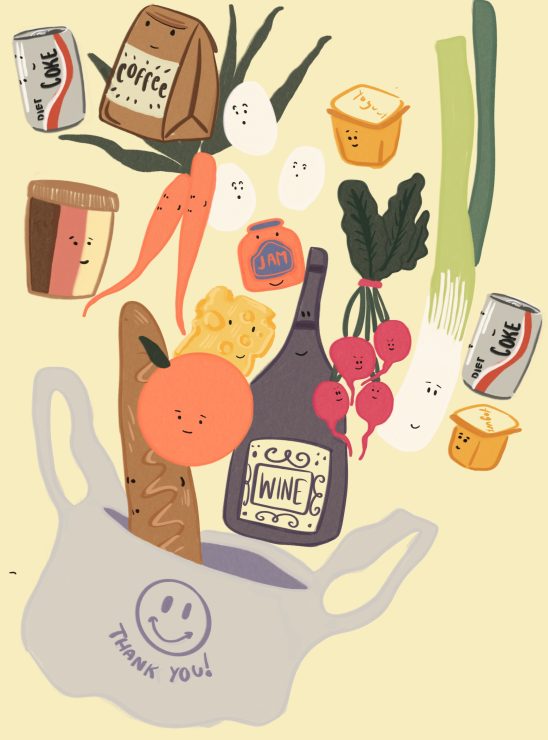Comparing prices across local grocery stores

Illustration by Chloe Latour.
Trying to eat healthy can be hard. Trying to eat cheaply can be hard. Eating healthy and cheaply feels nearly impossible.
I remember just a few years ago I felt excited to go grocery shopping. I would think about new recipes I wanted to try or plan what I was going to eat for the week. No matter what, I would always pick out a few of my favourite snacks to have stocked up.
Things have changed.
That excitement has turned into fear of what the register is going to say. Just the other day, I walked into the Thrifty Foods near my house to pick up a few things to keep me going for the week. I was happy to see that there were great deals for several of my staple items. But despite the deals, despite only buying basic items, and despite forgoing any snacks, it still ended up costing nearly $40 for five items.
Thrifty Foods isn’t the cheapest place to shop, but it’s the closest grocery store to my house. Plus, I enjoy the quaint vibe inside and seeing the cashiers I’m used to. Recently, I decided to see how much I would actually save by going somewhere else instead.
For this experiment, I used the websites of four major grocery stores to compare how much an average midweek shop would cost for myself. I tried my best to choose similar items from each store. I also chose to ignore any sale prices to get an accurate price for what an item would normally be.
These are the groceries chosen:
- 3 pounds of apples
- 5 bananas
- 500 grams of Adams peanut butter
- 1 pound of extra firm tofu
- 5 pounds of russet potatoes
- 12 free run large brown eggs
- 750 grams of Greek yogurt
- 1 package of chocolate caramel rice cakes
- 3–4 Red bell peppers
- 750 grams of frozen peas
These are the total prices at each store:
Thrifty Foods: $58.93
Walmart: $48.44
Real Canadian Superstore: $55.20
Save-On-Foods: $60.77
In short, I should have just gone to Walmart, even though I despise setting foot in there. A $10 difference starts to add up quickly, especially when I grocery shop multiple times per week. I should have only shopped the deals or chosen cheaper alternatives. There are a lot of things I could or should do to spend less on food. But the sad truth is that I am part of the lucky few who even get to choose where I shop.
Food deserts are an issue that arise when people don’t have access to healthy and affordable food options within a reasonable distance. While food deserts are not a major issue in Victoria compared to other places, it is still a problem.
Not having a vehicle, mobility issues, and the Capital Regional District’s transit system can all make grocery shopping choices very limited for people. Sometimes spending that extra $12 dollars at Save-On-Foods isn’t a choice.
The annual Canada Food Price Report was released and does offer some hope. It is predicted that food prices in Canada will rise 2.5–4.5 per cent this year, compared to the 5–7 per cent predicted last year. A small change to be sure, but any bit of relief helps consumers.
A potentially concerning fact from the report is that Canadians are spending less on food, despite the prices rising.
On top of all this, the corporations that own these grocery stores like Loblaws and Sobeys continue to see record profits. It’s no wonder that Canadian food banks have seen unprecedented increases in use these past few years.
I wish that this could’ve been a simple list of ways to reduce your grocery bill, but there just isn’t a silver bullet to fix all of this. Healthy foods are expensive, unhealthy foods are expensive, and takeout is really expensive. The best advice I can give is try not to be discouraged, no matter how depressing grocery shopping can be.
If you are truly struggling to deal with the rising food costs, there are systems set up to help you. Here in Victoria we are lucky enough to have food banks open to anyone. The UVic food bank is open to all faculty and students of the university, and can be found in the basement of the Student Union Building.








